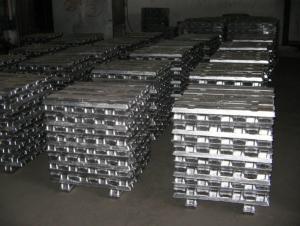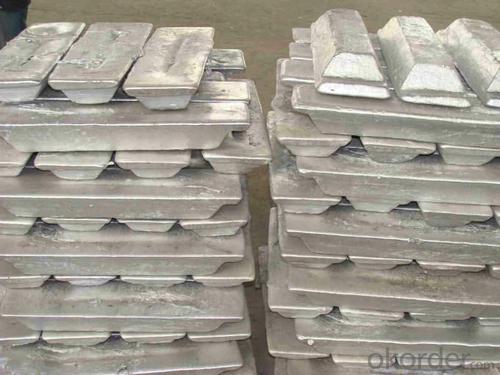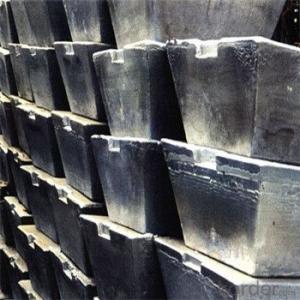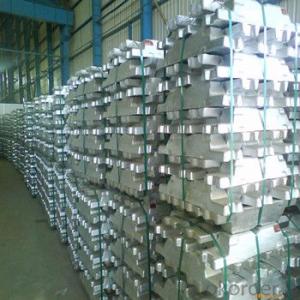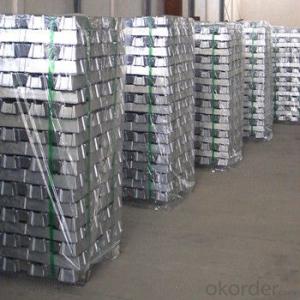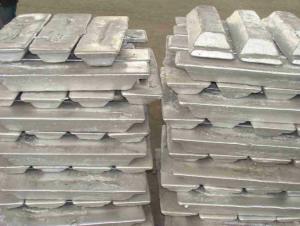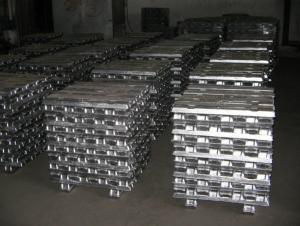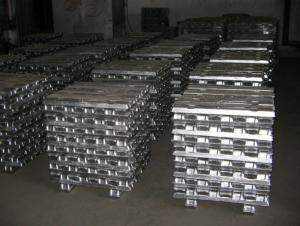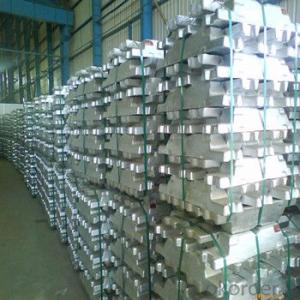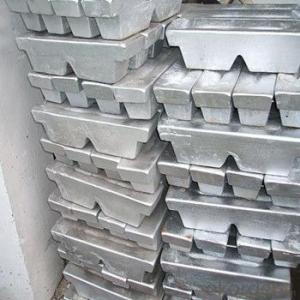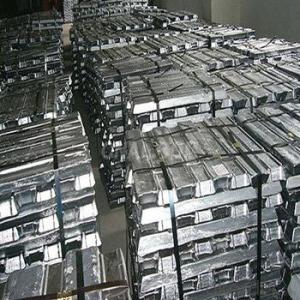Aluminum Ingots AA3005
- Loading Port:
- Shanghai
- Payment Terms:
- TT or LC
- Min Order Qty:
- 20 Tons m.t.
- Supply Capability:
- 1000 Sets Per Month m.t./month
OKorder Service Pledge
OKorder Financial Service
You Might Also Like
1. Specifications of Aluminum Ingots AA3005
Product Name | Aluminum Ingot |
Chemical Composition | Al |
Weight | 20/25kg |
Al (Min) | 99%-99.9% |
Appearance | silvery white |
Advantages | easy control and operation, fast melting |
Chemical composition of Aluminum Ingots AA3005
Grade | Chemical Composition % | |||||||||
Al≥ | Si | Fe | Cu | Ga | Mg | Zn | Mn | others | Sum | |
Al99.9 | 99.90 | 0.50 | 0.07 | 0.005 | 0.02 | 0.01 | 0.025 | - | 0.010 | 0.10 |
Al99.85 | 99.85 | 0.80 | 0.12 | 0.005 | 0.03 | 0.02 | 0.030 | - | 0.015 | 0.15 |
Al99.7 | 99.70 | 0.10 | 0.20 | 0.010 | 0.03 | 0.02 | 0.030 | - | 0.030 | 0.30 |
Al99.6 | 99.60 | 0.16 | 0.25 | 0.010 | 0.03 | 0.03 | 0.030 | - | 0.030 | 0.40 |
Al99.5 | 99.50 | 0.22 | 0.30 | 0.020 | 0.03 | 0.05 | 0.050 | - | 0.030 | 0.50 |
Al99.00 | 99.00 | 0.42 | 0.50 | 0.020 | 0.03 | 0.05 | 0.050 | - | 0.050 | 1.00 |
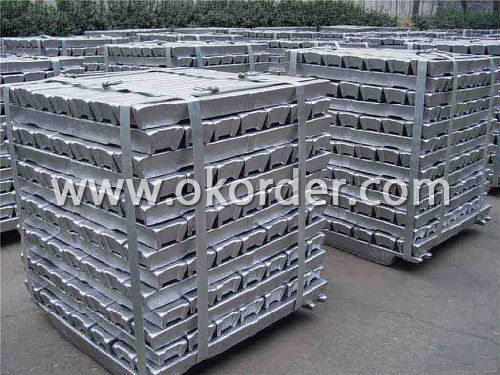
2. Usage/Application of Aluminum Ingots AA3005
1. mainly used for melting ingot
2. discontinuous melting with scrap
3. easy control and operation
4. fast melting
5. Used for industry such as automobile,pinning and weaving,electron broadly and so on
3.Packaging & Delivery of Aluminum Ingots AA3003
About 25Kg /Ingot, Packed in wooden case, Net weight 1000Kg/ Case, or as customer's requirements.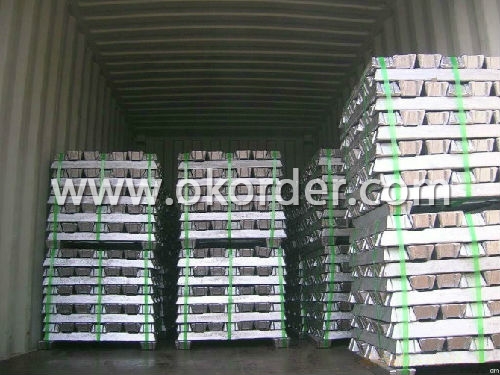
- Q: How is aluminium powder made into aluminium ingot?
- If it is pure aluminum powder, then it needs smelting forming
- Q: How are aluminum ingots used in the production of furniture?
- Aluminum ingots find various applications in the production of furniture. Primarily, they serve as the main raw material for creating lightweight and long-lasting furniture frames. The ingots are melted and shaped into desired forms and sizes, forming the structure or skeleton of the furniture piece. Once the aluminum frame is formed, it undergoes further processing, such as cutting, bending, and welding, to achieve the desired design and functionality. This allows for the creation of intricate and contemporary furniture designs that are visually appealing and practical. In addition, aluminum ingots are commonly utilized in the production of outdoor furniture due to their excellent resistance to corrosion. Outdoor furniture faces harsh weather conditions, and the natural resistance of aluminum to rust and deterioration makes it an ideal choice for such applications. Furthermore, aluminum ingots can be employed to create different furniture components, including legs, armrests, and decorative elements. These components are then assembled with other materials, such as wood, glass, or fabric, to create the final furniture product. The use of aluminum ingots in furniture production offers various advantages. Aluminum is lightweight, making it easy to move and rearrange the furniture. It also provides exceptional strength and durability, ensuring the furniture's longevity. Moreover, aluminum is highly recyclable, making it an environmentally friendly choice for furniture manufacturing. In conclusion, aluminum ingots play a crucial role in furniture production. They are transformed into frames, components, and decorative elements, providing lightweight, durable, and stylish furniture options. The versatility and sustainability of aluminum make it a preferred choice for furniture manufacturers, particularly for outdoor and modern designs.
- Q: What are the different extrusion processes for aluminum ingots?
- There are several different extrusion processes for aluminum ingots, each with its own unique characteristics and applications. Some of the most commonly used extrusion processes for aluminum include: 1. Direct extrusion: This is the most common extrusion process for aluminum ingots. In this process, the ingot is heated and then forced through a die using a ram or a hydraulic press. The material flows in the same direction as the ram, resulting in a continuous profile with a consistent cross-section. 2. Indirect extrusion: In this process, the die is stationary and the ingot is forced through the die using a hollow ram. The material flows in the opposite direction of the ram, resulting in a profile with a higher surface finish and improved mechanical properties. 3. Impact extrusion: This process is used to create hollow shapes, such as tubes or containers, by striking a punch against the ingot. The force of the impact causes the metal to flow around the punch, forming the desired shape. Impact extrusion is often used for high-volume production of small parts. 4. Cold extrusion: Unlike the previous processes which involve heating the ingot, cold extrusion is performed at room temperature. The ingot is placed in a die and compressed using a hydraulic press or mechanical force. Cold extrusion is commonly used for producing complex shapes with tight tolerances and excellent surface finish. 5. Hydrostatic extrusion: This process involves placing the ingot in a sealed chamber filled with a liquid, typically oil or water. Pressure is applied to the liquid, which in turn applies even pressure on the ingot. Hydrostatic extrusion is often used for extruding alloys with low ductility or complex shapes. Each extrusion process has its advantages and limitations, and the choice depends on factors such as the desired product shape, material properties, production volume, and cost considerations.
- Q: The mold is aluminum magnesium ingot foundry made it
- As for an iron mold shell, there is no high technical requirement, and the general casting method can be large, then it is better to V die
- Q: What are the main factors influencing the choice between aluminum ingots and aluminum wires?
- The main factors influencing the choice between aluminum ingots and aluminum wires are the intended use or application, cost considerations, and the manufacturing process.
- Q: How to cast aluminum ingots
- The cast aluminum heating to 800 DEG C, then slag, into the mold.
- Q: What are the energy requirements for producing aluminum ingots?
- The energy requirements for producing aluminum ingots can vary depending on several factors such as the type of production process, the source of energy used, and the efficiency of the production facility. However, generally, the production of aluminum ingots is an energy-intensive process. The primary method for producing aluminum ingots is through the smelting of aluminum oxide, or alumina, which is obtained from bauxite ore. The most common method used is the Hall-Héroult process, which involves the electrolysis of alumina dissolved in a molten cryolite electrolyte. In this process, a significant amount of energy is required to heat the alumina to its melting point of around 2,040 degrees Celsius and maintain it at this temperature. The energy is typically provided by large electric currents passed through the molten electrolyte, where the electrolysis takes place. Additionally, the production of aluminum ingots requires a substantial amount of electrical energy to break the chemical bonds in the alumina and separate the aluminum metal from the oxygen. The electrolysis process consumes a substantial amount of electricity, making aluminum production one of the largest consumers of electrical energy worldwide. The energy requirements for producing aluminum ingots can also be influenced by the source of electricity used. If renewable energy sources such as hydropower, wind power, or solar power are utilized, the environmental impact and carbon footprint of aluminum production can be significantly reduced. On the other hand, if the electricity is generated from non-renewable sources such as coal or natural gas, the energy requirements may be higher and contribute to higher greenhouse gas emissions. Efficiency improvements and technological advancements have been made in aluminum production processes over the years, leading to reductions in energy consumption. For example, the development of pre-baked anode technology has increased the energy efficiency of the Hall-Héroult process. Furthermore, recycling aluminum requires significantly less energy compared to primary production from bauxite ore, making it a more sustainable and energy-efficient option. In conclusion, the energy requirements for producing aluminum ingots are substantial due to the high temperatures required for the smelting process and the electricity needed for electrolysis. However, advancements in technology and the utilization of renewable energy sources can help reduce the energy consumption and environmental impact of aluminum production.
- Q: How can the safety measures in aluminum ingot production be enhanced?
- There are multiple ways to enhance safety measures in aluminum ingot production: 1. Proper training programs should be implemented. It is crucial to provide comprehensive training to all employees involved in the production process. This training should cover the correct handling of equipment, awareness of potential hazards, and adherence to safety protocols. 2. Regular safety inspections should be conducted. Routine inspections of the production area can help identify potential safety hazards. This includes checking equipment for wear and tear, ensuring proper ventilation, and identifying potential fire or chemical hazards. 3. Access to and proper training in using personal protective equipment (PPE) is essential. All workers should have access to appropriate PPE, such as safety goggles, gloves, helmets, and protective clothing. This will help prevent accidents and exposure to hazardous materials. 4. A robust hazard communication program should be implemented. It is crucial to inform workers about potential risks associated with aluminum ingot production. This includes labeling hazardous materials, providing safety data sheets, and conducting regular safety meetings to keep workers informed about any updates or changes in safety procedures. 5. Emergency response plans should be developed and practiced. Having clearly defined evacuation routes, establishing communication protocols during emergencies, and training workers on how to respond to different types of emergencies, such as fires or chemical spills, are vital for mitigating risks. 6. Regular maintenance and equipment checks are necessary. Ensuring that all equipment used in the production process is regularly maintained and serviced can help prevent malfunctions and potential accidents. Regular checks and maintenance should include inspecting electrical systems, machinery, and other equipment for any signs of damage or wear. 7. Encouraging a culture of continuous improvement and monitoring is essential. It is important to identify and address any safety concerns. This can be achieved through regular safety audits, soliciting feedback from employees, and implementing necessary changes to improve safety measures. By implementing these measures, safety in aluminum ingot production can be significantly enhanced, minimizing the risk of accidents, injuries, and potential hazards.
- Q: How are aluminum ingots used in the production of heat sinks?
- Aluminum ingots are melted down and then cast into specific shapes and sizes to create heat sinks. These heat sinks are then used in various electronic devices to dissipate heat and cool down the components, ensuring their optimal performance and longevity.
- Q: How can the sustainability practices in aluminum ingot production be enhanced?
- The sustainability practices in aluminum ingot production can be enhanced by implementing measures such as increasing energy efficiency, adopting renewable energy sources, reducing waste generation and implementing recycling programs, minimizing water usage, optimizing transportation and logistics processes, and promoting responsible sourcing of raw materials. Additionally, investing in research and development to develop innovative and eco-friendly technologies can further enhance sustainability practices in aluminum ingot production.
1. Manufacturer Overview
| Location | Henan,China |
| Year Established | 1993 |
| Annual Output Value | Above US$200 Million |
| Main Markets | Mid East;Eastern Europe;North America |
| Company Certifications | ISO 9001:2000;ISO 14001:2004;OHSAS 18001 |
2. Manufacturer Certificates
| a) Certification Name | |
| Range | |
| Reference | |
| Validity Period |
3. Manufacturer Capability
| a) Trade Capacity | |
| Nearest Port | Shanghai |
| Export Percentage | 30%-50% |
| No.of Employees in Trade Department | 21-50 People |
| Language Spoken: | English;Chinese |
| b) Factory Information | |
| Factory Size: | Above 100,000 square meters |
| No. of Production Lines | Above 10 |
| Contract Manufacturing | OEM Service Offered;Design Service Offered |
| Product Price Range | Average |
Send your message to us
Aluminum Ingots AA3005
- Loading Port:
- Shanghai
- Payment Terms:
- TT or LC
- Min Order Qty:
- 20 Tons m.t.
- Supply Capability:
- 1000 Sets Per Month m.t./month
OKorder Service Pledge
OKorder Financial Service
Similar products
Hot products
Hot Searches
Related keywords


